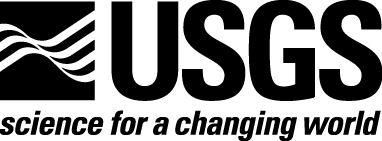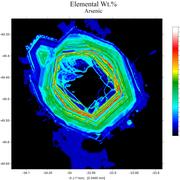Due to a lapse in appropriations, the majority of USGS websites may not be up to date and may not reflect current conditions. Websites displaying real-time data, such as Earthquake and Water and information needed for public health and safety will be updated with limited support. Additionally, USGS will not be able to respond to inquiries until appropriations are enacted. For more information, please see www.doi.gov/shutdown
National Laboratories Program
Home
Programs L2 Landing Page
The USGS maintains a variety of high quality, state-of-the-art scientific facilities that provide analytical capabilities, scientific support functions, experimental and modeling expertise, and field capabilities. Two of these facilities are housed in Denver, Colorado at the Federal Center and at Stanford University near the Menlo Park USGS campus.
SHRIMP-RG
SHRIMP-RG stands for Sensitive High-Resolution Ion Microprobe with Reverse Geometry. We are committed to making SHRIMP-RG available to the scientific community and seek projects that require spatially resolved measurements and benefit from SHRIMP-RG's unique combination of high secondary transmission and high mass resolving power.
TRIGA Reactor
We operate a low–enriched uranium–fueled, pool–type reactor, the Geological Survey TRIGA® Reactor, to support science by providing information on geologic, plant, and animal specimens to advance methods and techniques unique to nuclear reactors. Samples from around the world are submitted to the USGS for analysis using the reactor facility.
National Ice Core Laboratory
The U.S. National Ice Core Laboratory is a facility for storing, curating, and studying ice cores recovered from the polar regions of the world. It provides scientists with the capability to conduct examinations and measurements on ice cores, and it preserves the integrity of these ice cores in a repository for current and future investigations.
Denver Microbeam Laboratory
The laboratory capabilities include imaging, x-ray analysis, x-ray mapping, image processing, and optical microscopy.
Geologic map of the Fort Collins 30'×60' quadrangle, Larimer and Jackson Counties, Colorado, and Albany and Laramie Counties, Wyoming
The rocks and landforms of the Fort Collins 30′ × 60′ 1:100,000-scale U.S. Geological Survey quadrangle reveals a particularly complete record of geologic history in the northern Front Range of Colorado. The Proterozoic basement rocks exposed in the core of the range preserve evidence of Paleoproterozoic marine sedimentation, volcanism, and...
Workman, Jeremiah B.; Cole, James C.; Shroba, Ralph R.; Kellogg, Karl S.; Premo, Wayne R.Descriptive models for epithermal gold-silver deposits: Chapter Q in
Epithermal gold-silver deposits are vein, stockwork, disseminated, and replacement deposits that are mined primarily for their gold and silver contents; some deposits also contain substantial resources of lead, zinc, copper, and (or) mercury. These deposits form in the uppermost parts of the crust, at depths less than about 1,500 meters below the...
John, David A.; Vikre, Peter G.; du Bray, Edward A.; Blakely, Richard J.; Fey, David L.; Rockwell, Barnaby W.; Mauk, Jeffrey L.; Anderson, Eric D.; Graybeal, Frederick T.Understanding the captivity effect on invertebrate communities transplanted into an experimental stream laboratory
Little is known about how design and testing methodologies affect the macroinvertebrate communities that are held captive in mesocosms. To address this knowledge gap, we conducted a 32‐d test to determine how seeded invertebrate communities changed once removed from the natural stream and introduced to the laboratory. We evaluated larvae survival...
Schmidt, Travis S.; Rogers, Holly; Miller, Janet L.; Mebane, Christopher A.; Balistrieri, Laurie S.Distinguishing brackish lacustrine from brackish marine deposits in the stratigraphic record: A case study from the late Miocene and early Pliocene Bouse Formation, Arizona and California, USA
Brackish marine and brackish continental environments are fundamentally different from a compositional perspective. Brackish water is often defined as having salinity lower than that of standard seawater but higher than that of freshwater, but less regard is given to the origin of the salts involved. The simple dilution of...
Bright, Jordon; Cohen, Andrew S.; Starratt, Scott W.Paleoseismic results from the Alpine site, Wasatch fault zone: Timing and displacement data for six holocene earthquakes at the Salt Lake City–Provo segment boundary
To improve the characterization of Holocene earthquakes on the Wasatch fault zone (WFZ), we conducted light detection and ranging (lidar)‐based neotectonic mapping and excavated a paleoseismic trench across an 8‐m‐high fault scarp near Alpine, Utah, located <1  km"><1 km<1 km south of the boundary...
Bennett, Scott E. K.; Duross, Christopher; Gold, Ryan D.; Briggs, Richard; Personius, Stephen; Reitman, Nadine G.; Devore, Joshua; Hiscock, Adam; Mahan, Shannon A.; Gray, Harrison; Gunnarson, Sydney; Stephenson, William J.; Pettinger, Elizabeth; Odum, Jackson K.Aeromagnetic map of Mountain Pass and vicinity, California and Nevada
Magnetic investigations of Mountain Pass and vicinity were begun as part of an effort to study regional crustal structures as an aid to understanding the geologic framework and mineral resources of the eastern Mojave Desert. The study area, which straddles the state boundary between southeastern California and southern Nevada, encompasses Mountain...
Ponce, David A.; Ponce, David A.; Denton, Kevin M.Isostatic gravity map of Mountain Pass and vicinity, California and Nevada
Gravity investigations of Mountain Pass and vicinity were begun as part of an effort to study regional crustal structures as an aid to understanding the geologic framework and mineral resources of the eastern Mojave Desert. The study area, which straddles the state boundary between southeastern California and southern Nevada, encompasses Mountain...
Ponce, David A.; Ponce, David A.; Denton, Kevin M.Geophysical and geologic maps of Mountain Pass and vicinity, California and Nevada
U.S. Geological Survey Scientific Investigations Map 3412 is a series of products that consists of geophysical and geologic maps of Mountain Pass and vicinity, California. Maps A and B (red outline in above map image) are gravity and aeromagnetic maps, respectively. The map series was begun as part of an effort to study regional crustal structures...
Ponce, David A.Thermally induced fracture of macroscale surficial granite sheets
Geologically diverse landforms around the world show indications of energetic macroscale fracture. These fractures are sometimes displayed dramatically as so-called “A-tents”, whereby relatively thin rock sheets push upwards and fracture, forming tent-like voids beneath the ruptured sheets. The origin and formation of such features has been a...
Collins, Brian D.; Stock, Greg M.; Eppes, Martha C.Geologic map of the Castle Rock 7.5' quadrangle, Arizona and California
The Castle Rock quadrangle is in the northeast corner of Chemehuevi Valley, California and Arizona. It includes the Colorado River’s entrance to the valley at the mouth of Topock Gorge and the northern outskirts of Lake Havasu City, Arizona, and the Chemehuevi Indian Tribe community of Havasu Lake, California. The map includes large parts of the...
House, P. Kyle; John, Barbara E.; Malmon, Daniel V.; Block, Debra; Beard, L. Sue; Felger, Tracey J.; Crow, Ryan S.; Schwing, Jonathan E.; Cassidy, Colleen E.Framework geologic map and structure sections along the Bartlett Springs Fault Zone and adjacent area from Round Valley to Wilbur Springs, northern Coast Ranges, California
The geologic map and accompanying report describes the extent, complexity, architecture, and evolution of the Bartlett Springs Fault Zone between Clear Lake and Round Valley, California. This fault zone is the eastern-most known active member of the San Andreas transform margin in northern California. It is of particular interest for its apparent...
McLaughlin, Robert J.; Moring, Barry C.; Hitchcock, Christopher S.; Valin, Zenon C.Bedrock mapping and seismic hazard assessment at Gold Basin landslide, Washington
The Gold Basin landslide is located along the South Fork Stillaguamish River, within the Mount Baker-Snoqualmie National Forest in western Washington State. Recent concerns related to slope stability after the 2014 State Route 530 Landslide near Oso, Washington, forced the closure of the U.S. Forest Service Gold Basin Campground in May of 2014. In...
Staisch, Lydia M.











